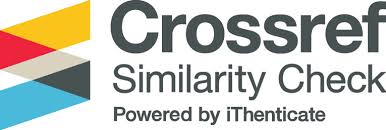The Purification effect on Organoleptic Profile, Yield, Total Phenol and Total Flavonoids from 96% Ethanol Extract of Moringa (Moringa oleifera. L) leaves.
Abstract
Purification extract ethanol 96% of Moringa dry leaves was carried out to increase the active substance content and to obtain a more attractive color. The purpose of this study was to determine the type of solvent in the fractionation which provides a higher active substance content than the extract.
This research begins with maceration of dried Moringa leaves with 96% ethanol. The filtrate that has been dried then purified. Purification begins with dissolving the extract in hot distilled water with a ratio of 1:10, after that ethyl acetate or n-hexane is added to the same amount as hot distilled water in a separating funnel, shaking it. The ethyl acetate or n-hexane phase is taken then the filtrate obtained is combined. The 96% ethanol extract (E1), ethyl acetate (E2) and n-hexane (E3) were then evaluated with parameters of organoleptic, % yield, total phenol, and total flavonoids. Data were analyzed statistically one way ANOVA with confidence level of 95%.
The measurement results for E1, E2, and E3 in the yield were 15.81%;22.18%;20%, the total phenol was 28.94±0.54mgGAE/g; 29.44±0.93mgGAE/g; 11,41±0,12mgGAE/g, and total flavonoids 3,19±0.13%; 9,92±0.06%; 5.81±0.18% respectively. The consistency, smell and taste, all are identical, while in color, E2 is more yellowish green and brighter, making it more attractive. Statistically, there were significant differences between E1, E2, and E3 in total phenols and flavonoids. Thus it can be concluded that E2 significantly higher total phenol and flavonoids than E1 and E3.
References
[2] Abd-Rani N.Z., Husain K., Kumolosasi E. 2018. Moringa Genus: A Review of Phytochemistry and Pharmacology. Front. Pharmacol. 9:108. doi: 10.3389/fphar.2018.00108.
[3] Krisnadi AD. 2013. Kelor Super Nutrisi. Pusat Informasi dan Pengembangan Tanaman Kelor Indonesia Lembaga Swadaya Masyarakat Media Peduli Lingkungan. Blora.
[4] Gopalakrishnan L, Doriya K, Kumar DS. 2016. Moringa oleifera: A review on nutritive importance and its medicinal application. Food Science and Human Wellness 5:49-56
[5] Singh R.S.G., Negi P.S., Radha C. 2013. Phenolic composition, antioxidant and antimicrobial activities of free and bound phenolic extracts of Moringa oleifera seed flour. J. Funct. Foods. 5:1883–1891. doi: 10.1016/j.jff.2013.09.009.
[6] Vergara-Jimenez M., Almatrafi M.M., Fernandez M.L. 2017. Bioactive Components in Moringa oleifera Leaves Protect against Chronic Disease. Antioxidants. 6:91. doi: 10.3390/antiox6040091.
[7] Markham, K. R., 1998, Cara Mengidentifikasi Flavonoid, ITB Press, Bandung.
[8] Vongsak, B., Sithisarn, P., Mangmool, S., Thongpraditchote, S., Wongkrajang, Y., Gritsanapan, W., 2013, Maximizing total phenolics, total flavonoids contents and antioxidant activity of Moringa oleifera leaf extract by the appropriate extraction method, Industrial Crops and Products. Elsevier B.V., 44: 566–571.
[9] Departemen Kesehatan RI, 2000, Parameter Standar Umum Ekstrak Tumbuhan Obat, Cetakan Pertama, 3-11, 17-19, Dikjen POM, Direktorat Pengawasan Obat Tradisional.
[10] Departemen Kesehatan Republik Indonesia. 2008. Farmakope Herbal Indonesia, Edisi I, Departemen Kesehatan Republik Indonesia, Jakarta, Indonesia.
[11] Abidin, Z., Khaeriah, U., Zuhrina, Z., Pratama, M., & Baits, M. 2019. Tyrosinase Inhibitor Activity Measurement of Crude and Purified Extract of Moringa Leaves (Moringa oleifera L.). Indonesian Journal of Pharmaceutical Science and Technology, 1(1). https://doi.org/10.24198/IJPST.V1I1.19152
[12] Chang C. Yang M, Wen Hand Chern J. 2002. Estimation of Total Flavonoid Content in Propolis by Two Complementary Colorimetric Methods, J. Food Drug Anal.
[13] Ainsworth EA, Gillespie KM. Estimation of total phenolic content and other oxidation substrates in plant tissues using Folin- Ciocalteu reagent. Nat Protoc. 2007;2(4):875–877.
[14] Azwar, Saifuddin. 2011. Metode Penelitian. Yogyakarta: Pustaka Pelajar.
[15] Viranda, P. M. 2009. Pengujian Kandungan Tomat. Jakarta. Fakultas Kedokteran. Universitas. Indonesia.
[16] Kusbandari, Aprilia; Susanti, Hari. 2011. Kandungan Beta Kroten dan Aktivitas Penangkapan Radikal Bebas terhadap DPPH (1,1-difenil 2-pikrilhidrazil) Ekstrak Buah Blewah (Cucumis melo var. Cantalupensis L) Secara Spektrofotometri UV-Visibel. Yogyakarta. JURNAL FARMASI SAINS DAN KOMUNITAS, Mei 2017, hlm. 37-42
[17] Orthmer, Kirk. 1961. Encyclopedia of Chemical Technology. 3th edition. Volume 5 dan 19. John Wiley & Son, Inc. New York
[18] Dutia, P, 2004, Ethyl Acetate: A Techno-Commercial Profile, Chemical Weekly, pp: 179-186.
[19] NN. 2008. Hexane. (Online). (http://wikipedia.org, diakses 15 Maret 2015)
[20] Alexandra B Bentz. 2009. A Review of Quercetin: Chemistry, Antioxidant Properties, and Bioavailability. Journal of young investigayor.
[21] Narayana, K.R., Reddy, M.S., Chaluvadi, M.R., and Krishna, D.R., 2001, Bioflavonoids Classification, Pharmacological, Biochemical Effect and Therapeutic Potential, Indian Journal of Pharmacology, vol. 33, n0.1, pp.2-16.
[22] Eka Nur Kamilah, 2015. Pengaruh keterampilan mengajar guru terhadap hasil belajar siswa pada mata pelajaran Akuntansi. Universitas Pendidikan Indonesia.













